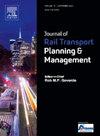Integrated optimization of energy-efficient train timetable and rolling stock circulation plan with regenerative energy utilization
IF 2.7
Q3 TRANSPORTATION
Journal of Rail Transport Planning & Management
Pub Date : 2024-12-24
DOI:10.1016/j.jrtpm.2024.100499
引用次数: 0
Abstract
With the running and dwell levels considered, we investigate the integrated energy-efficient train timetabling and rolling stock circulation planning problem for a metro line, where the passenger demand is considered via the service pattern. A mixed integer non-linear programming model is proposed to minimize the headway variations, headway deviations, the number of required rolling stocks, and the net energy consumption. Specifically, the regenerative energy utilization is considered by the brake-traction overlapping times. After linearization, the energy-efficient timetabling problem can be solved by existing solvers. A two-step method is presented to enhance the computational efficiency. In the first step, the arrival times of train services at the first station are determined. In the second step, the timetable and rolling stock circulation plan are optimized according to the given arrival times at the first station. Two case studies with different service patterns are conducted based on the data of Beijing Yizhuang metro line. The computational results demonstrate that the two-step method can reduce the optimality gap sharply. Compared with the energy-efficient model without the consideration of regenerative energy utilization, the regenerative energy utilization of the model with regenerative energy utilization considered increases 25.64% and 35.95% in the two test cases, respectively.
考虑可再生能源利用的节能列车时刻表与车辆流通方案的综合优化
在考虑运行水平和停留水平的情况下,研究了通过服务模式考虑乘客需求的地铁线路综合节能列车调度和车辆循环规划问题。提出了一种混合整数非线性规划模型,以最小化车头距变化、车头距偏差、所需车辆数量和净能耗。具体地说,再生能量利用是通过制动-牵引重叠次数来考虑的。线性化后的节能调度问题可以用已有的求解器求解。为了提高计算效率,提出了一种两步法。第一步,确定列车服务到达第一站的时间。第二步,根据给定的到站时间,优化列车时刻表和车辆循环方案。以北京亦庄地铁线路为例,进行了两种不同服务模式的案例分析。计算结果表明,两步法能显著减小最优性间隙。与不考虑可再生能源利用的节能模型相比,考虑可再生能源利用的节能模型在两个测试案例中的可再生能源利用率分别提高了25.64%和35.95%。
本文章由计算机程序翻译,如有差异,请以英文原文为准。
求助全文
约1分钟内获得全文
求助全文
来源期刊

Journal of Rail Transport Planning & Management
TRANSPORTATION-
CiteScore
7.10
自引率
8.10%
发文量
41
 求助内容:
求助内容: 应助结果提醒方式:
应助结果提醒方式:


